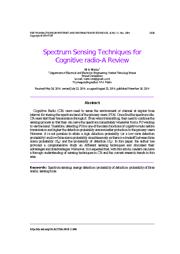A copy of this work was available on the public web and has been preserved in the Wayback Machine. The capture dates from 2022; you can also visit the original URL.
The file type is application/pdf.
Spectrum Sensing Techniques for Cognitive Radio-A Review
2014
KSII Transactions on Internet and Information Systems
Cognitive Radio (CR) users need to sense the environment or channel at regular time interval for sharing the spectrum band of the primary users (PUs). Once find the spectrum idle, CR users start their transmission through it. Even while transmitting, they need to continue the sensing process so that they can leave the spectrum immediately whenever find a PU wanting to use the band. Therefore, detecting PUs is one of the main functions of cognitive radio before transmission and higher the
doi:10.3837/tiis.2014.11.001
fatcat:zfop5rags5acblxe24ss4xgkki

